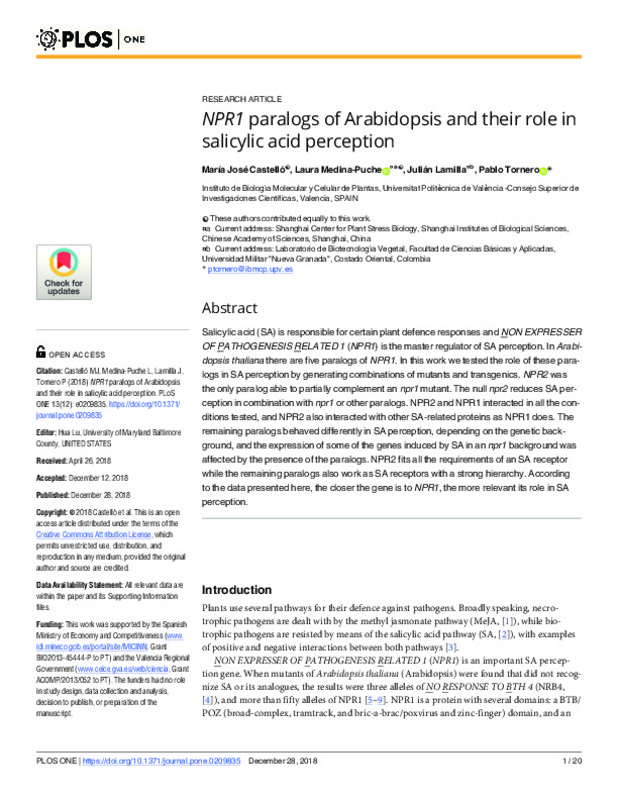JavaScript is disabled for your browser. Some features of this site may not work without it.
Buscar en RiuNet
Listar
Mi cuenta
Estadísticas
Ayuda RiuNet
Admin. UPV
NPR1 paralogs of Arabidopsis and their role in salicylic acid perception
Mostrar el registro sencillo del ítem
Ficheros en el ítem
| dc.contributor.author | Castelló Llopis, María José
|
es_ES |
| dc.contributor.author | Medina-Puche, Laura
|
es_ES |
| dc.contributor.author | Lamilla, J.
|
es_ES |
| dc.contributor.author | Tornero Feliciano, Pablo
|
es_ES |
| dc.date.accessioned | 2019-09-26T09:57:01Z | |
| dc.date.available | 2019-09-26T09:57:01Z | |
| dc.date.issued | 2018 | es_ES |
| dc.identifier.issn | 1932-6203 | es_ES |
| dc.identifier.uri | http://hdl.handle.net/10251/126416 | |
| dc.description.abstract | [EN] Salicylic acid (SA) is responsible for certain plant defence responses and NON EXPRESSER OF PATHOGENESIS RELATED 1 (NPR1) is the master regulator of SA perception. In Arabidopsis thaliana there are five paralogs of NPR1. In this work we tested the role of these paralogs in SA perception by generating combinations of mutants and transgenics. NPR2 was the only paralog able to partially complement an npr1 mutant. The null npr2 reduces SA perception in combination with npr1 or other paralogs. NPR2 and NPR1 interacted in all the conditions tested, and NPR2 also interacted with other SA-related proteins as NPR1 does. The remaining paralogs behaved differently in SA perception, depending on the genetic background, and the expression of some of the genes induced by SA in an npr1 background was affected by the presence of the paralogs. NPR2 fits all the requirements of an SA receptor while the remaining paralogs also work as SA receptors with a strong hierarchy. According to the data presented here, the closer the gene is to NPR1, the more relevant its role in SA perception. | es_ES |
| dc.description.sponsorship | This work was supported by the Spanish Ministry of Economy and Competitiveness (www.idi.mineco.gob.es/portal/site/MICINN, Grant BIO2013-45444-P to PT) and the Valencia Regional Government (www.ceice.gva.es/web/ciencia, Grant ACOMP/2013/052 to PT). The funders had no role in study design, data collection and analysis, decision to publish, or preparation of the manuscript. | es_ES |
| dc.language | Inglés | es_ES |
| dc.publisher | Public Library of Science | es_ES |
| dc.relation.ispartof | PLoS ONE | es_ES |
| dc.rights | Reconocimiento (by) | es_ES |
| dc.title | NPR1 paralogs of Arabidopsis and their role in salicylic acid perception | es_ES |
| dc.type | Artículo | es_ES |
| dc.identifier.doi | 10.1371/journal.pone.0209835 | es_ES |
| dc.relation.projectID | info:eu-repo/grantAgreement/GVA//ACOMP%2F2013%2F052/ | es_ES |
| dc.rights.accessRights | Abierto | es_ES |
| dc.contributor.affiliation | Universitat Politècnica de València. Instituto Universitario Mixto de Biología Molecular y Celular de Plantas - Institut Universitari Mixt de Biologia Molecular i Cel·lular de Plantes | es_ES |
| dc.description.bibliographicCitation | Castelló Llopis, MJ.; Medina-Puche, L.; Lamilla, J.; Tornero Feliciano, P. (2018). NPR1 paralogs of Arabidopsis and their role in salicylic acid perception. PLoS ONE. 13(12). https://doi.org/10.1371/journal.pone.0209835 | es_ES |
| dc.description.accrualMethod | S | es_ES |
| dc.relation.publisherversion | http://doi.org/10.1371/journal.pone.0209835 | es_ES |
| dc.type.version | info:eu-repo/semantics/publishedVersion | es_ES |
| dc.description.volume | 13 | es_ES |
| dc.description.issue | 12 | es_ES |
| dc.identifier.pmid | 30592744 | |
| dc.identifier.pmcid | PMC6310259 | |
| dc.relation.pasarela | S\382357 | es_ES |
| dc.contributor.funder | Generalitat Valenciana | es_ES |
| dc.contributor.funder | Ministerio de Economía y Empresa | es_ES |








